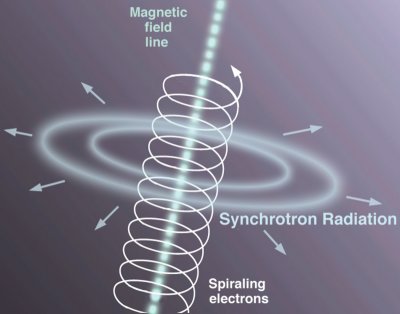synchrotron radiation

Image: Jon Lomberg/Gemini Observatory.
Synchrotron radiation is electromagnetic radiation emitted by electrons that are spiralling along, and therefore being constantly accelerated, in a magnetic field at a rate great enough for relativistic effects to be important. Predicted long ago, this radiation was first encountered in a particle accelerator called synchrotron. Much of the radiation observed by radio astronomers originates in this fashion.
Synchrotron radiation from cosmic sources has a distinctive spectrum, or distribution of photons with energy. The radiation falls off with energy less rapidly than does the spectrum of radiation from a hot gas. When synchrotron radiation is observed in supernova remnants, cosmic jets, or other sources, it reveals information about the high-energy electrons and magnetic fields that are present.


